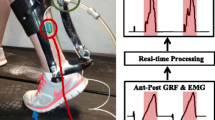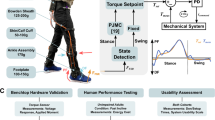Abstract
Neuromuscular impairment associated with cerebral palsy (CP) often leads to life-long walking deficits. Our goal was to evaluate the ability of a novel untethered wearable ankle exoskeleton to reduce the severity of gait pathology from CP. In this clinical feasibility study of five individuals with CP, we used instrumented gait analysis to quantify how powered plantar-flexor assistance affected gait mechanics following multi-visit acclimation. Compared to how each participant walked normally, walking with untethered exoskeleton assistance resulted in improved ankle plantar-flexion and knee extension; residual flexion deformity across the lower-extremity improved by a clinically significant 14.4° (p = 0.022). Powered plantar-flexor assistance increased average total positive ankle power by 44% (p = 0.037), and resulted in a 30% reduction in average negative biological ankle power (p = 0.004) and a 29% reduction in average positive hip power (p = 0.009). These findings suggest that powered ankle assistance augmented, rather than simply replaced, biological function to produce a more efficient gait pattern, which was corroborated by a 19% improvement in metabolic cost of transport (p = 0.011). This study provides evidence in support of the continued investigation of ankle assistance in mobility and rehabilitation interventions for this patient population.







Similar content being viewed by others
References
Armand, S., G. Decoulon, and A. Bonnefoy-Mazure. Gait analysis in children with cerebral palsy. EFORT open Rev. 1:448–460, 2016.
Bell, K. J., S. Ounpuu, P. A. DeLuca, and M. J. Romness. Natural progression of gait in children with cerebral palsy. J. Pediatr. Orthop. 22:677–682, 2002.
Bjornson, K. F., B. Belza, D. Kartin, R. Logsdon, and J. F. McLaughlin. Ambulatory physical activity performance in youth with cerebral palsy and youth who are developing typically. Phys. Ther. 87:248–257, 2007.
Boyle, C. A., S. Boulet, L. A. Schieve, R. A. Cohen, S. J. Blumberg, M. Yeargin-Allsopp, S. Visser, and M. D. Kogan. Trends in the prevalence of developmental disabilities in US children, 1997–2008. Pediatrics 127:1034–1042, 2011.
Brockway, J. M. Derivation of forulae used to calculate energy expenditure in man. Hum. Nutr. Clin. Nutr. 41C:463–471, 1987.
Browning, R. C., J. R. Modica, R. Kram, and A. Goswami. The effects of adding mass to the legs on the energetics and biomechanics of walking. Med. Sci. Sports Exerc. 39:515–525, 2007.
Burdea, G. C., D. Cioi, A. Kale, W. E. Janes, S. A. Ross, and J. R. Engsberg. Robotics and gaming to improve ankle strength, motor control, and function in children with cerebral palsy: a case study series. IEEE Trans. Neural Syst. Rehabil. Eng. 21:165–173, 2013.
Collins, S. H., M. B. Wiggin, and G. S. Sawicki. Reducing the energy cost of human walking using an unpowered exoskeleton. Nature 522:212–215, 2015.
Corry, I. S., A. P. Cosgrove, C. M. Duffy, T. C. Taylor, and H. K. Graham. Botulinum toxin A in hamstring spasticity. Gait Posture 10:206–210, 1999.
Damiano, D. L. Activity, activity, activity: Rethinking our physical therapy approach to cerebral palsy. Phys. Ther. 86:1534–1540, 2006.
Damiano, D. L., K. E. Alter, and H. Chambers. New clinical and research trends in lower extremity management for ambulatory children with cerebral palsy. Phys. Med. Rehabil. Clin. N Am. 20:469–491, 2009.
Damiano, D. L., A. S. Arnold, K. M. Steele, and S. L. Delp. Can strength training predictably improve gait kinematics? A pilot study on the effects of hip and knee extensor strengthening on lower-extremity alignment in cerebral palsy. Phys. Ther. 90:269–279, 2010.
Damiano, D. L., L. A. Prosser, L. A. Curatalo, and K. E. Alter. Muscle plasticity and ankle control after repetitive use of a functional electrical stimulation device for foot drop in cerebral palsy. Neurorehabil. Neural Repair 27:200–207, 2013.
De Mattos, C., K. Patrick Do, R. Pierce, J. Feng, M. Aiona, and M. Sussman. Comparison of hamstring transfer with hamstring lengthening in ambulatory children with cerebral palsy: further follow-up. J. Child. Orthop. 8:513–520, 2014.
Delp, S. L., F. C. Anderson, A. S. Arnold, P. Loan, A. Habib, C. T. John, E. Guendelman, and D. G. Thelen. OpenSim: Open-source software to create and analyze dynamic simulations of movement. IEEE Trans. Biomed. Eng. 54:1940–1950, 2007.
Dodd, K. J., N. F. Taylor, and D. L. Damiano. A systematic review of the effectiveness of strength-training programs for people with cerebral palsy. Arch. Phys. Med. Rehabil. 83:1157–1164, 2002.
Dreher, T., D. Vegvari, S. I. Wolf, A. Geisbüsch, S. Gantz, W. Wenz, and F. Braatz. Development of knee function after hamstring lengthening as a part of multilevel surgery in children with spastic diplegia: A long-term outcome study. J. Bone Jt. Surg. Ser. A 94:121–130, 2012.
Duffell, L. D., N. Hope, and A. H. McGregor. Comparison of kinematic and kinetic parameters calculated using a cluster-based model and Vicon’s plug-in gait. Proc. Inst. Mech. Eng. Part H J Eng. Med. 228:206–210, 2014.
Gagliardi, C., A. C. Turconi, E. Biffi, C. Maghini, A. Marelli, A. Cesareo, E. Diella, and D. Panzeri. Immersive virtual reality to improve walking abilities in cerebral palsy: a pilot study. Ann. Biomed. Eng. 2018. https://doi.org/10.1007/s10439-018-2039-1.
Ghasemi, A., and S. Zahediasl. Normality tests for statistical analysis: a guide for non-statisticians. Int. J. Endocrinol. Metab. 10:486–489, 2012.
Johnson, D. C., D. L. Damiano, and M. F. Abel. The evolution of gait in childhood and adolescent cerebral palsy. J. Pediatr. Orthop. 17:392–396, 1997.
Kang, J., D. Martelli, V. Vashista, I. Martinez-Hernandez, H. Kim, and S. K. Agrawal. Robot-driven downward pelvic pull to improve crouch gait in children with cerebral palsy. Sci. Robot. 2:eaan2634, 2017.
Lerner, Z. F., W. J. Board, and R. C. Browning. Pediatric obesity and walking duration increase medial tibiofemoral compartment contact forces. J. Orthop. Res. 34:97–105, 2016.
Lerner, Z. F., D. L. Damiano, and T. C. Bulea. A lower-extremity exoskeleton improves knee extension in children with crouch gait from cerebral palsy. Sci. Transl. Med. 9:1–11, 2017.
Lerner, Z. F., D. L. Damiano, and T. C. Bulea. The effects of exoskeleton assisted knee extension on lower-extremity gait kinematics, kinetics, and muscle activity in children with cerebral palsy. Sci. Rep. 7:13512, 2017.
Lerner, Z. F., G. M. Gasparri, M. O. Bair, J. L. Lawson, J. Luque, T. A. Harvey, and A. T. Lerner. An untethered ankle exoskeleton improves walking economy in a pilot study of individuals with cerebral palsy. IEEE Trans. Neural Syst. Rehabil. Eng. 2018. https://doi.org/10.1109/tnsre.2018.2870756.
Maltais, D., O. Bar-Or, V. Galea, and M. Pierrynowski. Use of orthoses lowers the O(2) cost of walking in children with spastic cerebral palsy. Med. Sci. Sports Exerc. 33:320–325, 2001.
McNee, A. E., A. P. Shortland, L. C. Eve, R. O. Robinson, and M. Gough. Lower limb extensor moments in children with spastic diplegic cerebral palsy. Gait Posture 20:171–176, 2004.
Mutlu, A., A. Livanelioglu, and M. K. Gunel. Reliability of Ashworth and Modified Ashworth Scales in children with spastic cerebral palsy. BMC Musculoskelet. Disord. 9:44, 2008.
Olney, S. J., H. E. MacPhail, D. M. Hedden, and W. F. Boyce. Work and power in hemiplegic cerebral palsy gait. Phys. Ther. 70:431–438, 1990.
Rethlefsen, S. A., S. Yasmeh, T. A. Wren, and R. M. Kay. Repeat hamstring lengthening for crouch gait in children with cerebral palsy. J. Pediatr. Orthop. 33:501–504, 2013.
Romkes, J., and R. Brunner. Comparison of a dynamic and a hinged ankle-foot orthosis by gait analysis in patients with hemiplegic cerebral palsy. Gait Posture 15:18–24, 2002.
Rose, J., J. G. Gamble, A. Burgos, J. Medeiros, and W. L. Haskell. Energy expenditure index of walking for normal children and for children with cerebral palsy. Dev. Med. Child Neurol. 32:333–340, 1990.
Sawicki, G. S., and D. P. Ferris. Mechanics and energetics of level walking with powered ankle exoskeletons. J. Exp. Biol. 211:1402–1413, 2008.
Steele, K. M., A. Seth, J. L. Hicks, M. S. Schwartz, and S. L. Delp. Muscle contributions to support and progression during single-limb stance in crouch gait. J. Biomech. 43:2099–2105, 2010.
Winter, D. A. Biomechanics and Motor Control of Human Movement. New York: Wiley, 1990.
Wren, T. A., S. Rethlefsen, and R. M. Kay. Prevalence of specific gait abnormalities in children with cerebral palsy: influence of cerebral palsy subtype, age, and previous surgery. J. Pediatr. Orthop. 25:79–83, 2005.
Acknowledgments
We thank Gian Maria Gasparri, Jason Luque, and Andrea Lerner for their critical assistance with this study. This study was supported in part by NIH Grant No. 1R03HD094583-01 and Arizona Department of Health Serves Grant No. ADHS18-198864.
Conflict of Interest
Z.F.L. is a named inventor on Provisional U.S. Patent Application No. 62/644,163, “Ankle Exoskeleton System and Method for Assisted Mobility and Rehabilitation” covering the exoskeleton used in the study.
Author information
Authors and Affiliations
Corresponding author
Additional information
Associate Editor Joel Stitzel oversaw the review of this article.
Publisher's Note
Springer Nature remains neutral with regard to jurisdictional claims in published maps and institutional affiliations.
Electronic supplementary material
Below is the link to the electronic supplementary material.
Rights and permissions
About this article
Cite this article
Lerner, Z.F., Harvey, T.A. & Lawson, J.L. A Battery-Powered Ankle Exoskeleton Improves Gait Mechanics in a Feasibility Study of Individuals with Cerebral Palsy. Ann Biomed Eng 47, 1345–1356 (2019). https://doi.org/10.1007/s10439-019-02237-w
Received:
Accepted:
Published:
Issue Date:
DOI: https://doi.org/10.1007/s10439-019-02237-w




